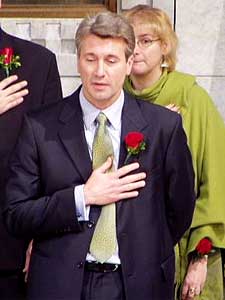|
Audio
Photos
More from MPR
Resources
|
 |
| Minneapolis Mayor R.T. Rybak listen to the National Anthem before his inauguration Tuesday morning. Rybak was elected to a second four-year term. (MPR Photo/Brandt Williams) |
Minneapolis, Minn. — City Clerk Merry Keefe administered the oath of office to Mayor R.T. Rybak on the marble steps of the City Hall rotunda. Rybak's wife and two children stood next to him as he pledged to uphold the constitutions of the United States and the state of Minnesota, and the laws of the city.
The ceremony took place in front of the silent 44-ton marble Father of Waters statue, and scores of not so silent friends, guests and colleagues who applauded after he took the oath.
Rybak began his address by mentioning the names of a few people who were alive four years ago when he was sworn in for his first term, but now were gone -- teenager Tyesha Edwards, who was killed by a stray bullet in her home; police officer Melissa Schmidt, who was killed in the line duty; and U.S. Sen. Paul Wellstone and his wife Sheila, who died in a plane crash in 2002, and who had attended his first inaugural. Rybak set aside two empty chairs in their honor.
And then Rybak turned to the future of the city.
"There are three core values that should be at the center of all of our work for these next few years, and they will be for mine," said Rybak. "The first of those is we must close the gap between haves and have-nots. The second is that we must reweave the urban fabric of Minneapolis. And the third is we must lay the groundwork for the next generation."
Rybak outlined several general policy directions designed to reflect the values of which he spoke. He pledged to make disproportionate investment in parts of the city with disproportionate needs.
Rybak used the Phillips neighborhood as an example. Some residents of the south Minneapolis neighborhood used to give "crack tours" of the area, showing off the proliferation of illegal drug trafficking that happened in broad daylight.
Rybak says that's changed, in part, with the renovation of the Sears building and its partnership with Allina, and Abbot Northwestern Hospital, which is located nearby.
"We know this strategy works. Look at the Phillips neighborhood, an area that was distressed a few years ago today is creating more jobs than any other part of the state of Minnesota," said Rybak. "Because we invested, because we looked at need, we are growing the city. We will do that again, in north Minneapolis and throughout the city of Minneapolis."
Rybak also expressed his desire for the city to become a collection of what he called "sustainable villages." He says those areas should contain good jobs and stores within walking distance of homes.
Rybak also previewed several youth initiatives. He says the next generation of children are growing up in a culturally mixed city, and are developing skills that can help Minneapolis adapt to the global economy.
Rybak will need the cooperation of the 13-member city council in order to see his vision come to fruition. That may not be a major political hurdle for the mayor, since 12 of the 13 members are -- like Rybak -- members of the DFL Party. One is a member of the Green Party.
There are also five new faces on the council -- one of them is Ralph Remington.
"I'm trying to get acclimated, trying to find out where the light switches are in the bathrooms," Remington said with a laugh.
Remington is one of two African Americans on the council. He was elected to serve the predominantly white 10th Ward, which includes much of Uptown.
Remington says he's looking forward to getting to know his colleagues better. He's also ready to get to work on housing and development issues. Remington says his stance on those issues is the main reason the voters sent him to City Hall.
"There's kind of a Wild West mentality with a lot of developers, wanting to -- understandably -- build as high and as much as they can. And that's all good," said Remington. "But I just want to make sure the buildings are sustainable, make sure it's smart development and linked to pedestrian-friendly, bicycle-friendly construction. And that we create walkable neighborhoods that are safe for all."
Following the swearing-in and a brief reception, the new council and mayor adjourned to the council chambers for some business. They unanimously elected 4th Ward councilmember Barb Johnson as the next council president. Following the vote, Johnson noted that her mother, Alice Rainville, was the first female council president in the history of the city.
The real work begins over the next few days. The council has a full schedule of committee meetings, starting Wednesday.





